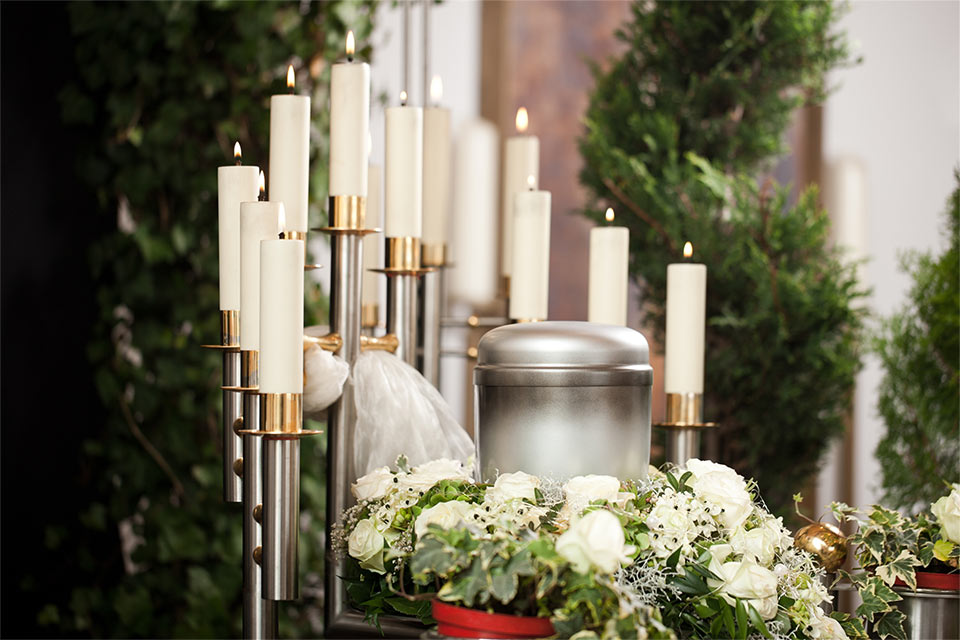The burying of ashes is service after the cremation process is completed. The ashes are collected and buried in a permanent location during the ashes ceremony. On the day of the interment, family and friends assemble at the burial site. A religious leader, funeral director, relative, or anybody close to the deceased can perform the burial ceremonies. In most cases, eulogies, prayers, and poems are read at the interment service. The law regarding the dispersion of ashes varies according to religion.
Table of Contents
What is an Ashes Interment?
Ashes can be interred in various ways, depending on various conditions. They could be interred in a cemetery, park, or other location selected by the deceased person. Alternatively, the ashes of a loved one are kept at home by the family as a memorial. A monument is sometimes erected at the burying plot to honor the dead. Cremation urns can be stored in a columbarium, holding a significant number of people’s ashes. A columbarium is similar to a mausoleum; however, it is built to house urns rather than bodies.
Choosing Cremation Rather Than Traditional Burial
Exhumed bodies have revealed that the decomposition process in typical graves takes several years, if not a few decades. In the case of cremation, the process is completed in a matter of hours, and the body is converted to ashes.
Instead of a coffin, ashes can be transported wherever in a cremation urn. Compared to a typical burial, an ashes interment takes up less room in a cemetery or graveyard; hence it is less expensive.
After a body is incinerated, the ashes must be interred, kept, or spread. The deceased’s funeral service might occur either before or after the cremation. Planning ahead of time makes cremation easier, especially while still living. By distributing written instructions to family members, it is possible to determine how the cremation will occur.
Preparing for a cremation service would save money and make things easier. Furthermore, the deceased’s family and friends would be able to say their final goodbyes without having to worry about making accommodations.
The Cremation Procedure
The cremation chamber, a specially designed furnace that emits tremendous heat through open flames, burns bodies. Crematoriums identify the body and proceed only if the concerned person or family member has permission.
Before identification, the body is cleaned. Items such as jewelry, prosthesis, and medical gadgets are removed to ensure a flawless cremation process.
Before being transported to the cremation chamber, the body is placed in a coffin or casket. The body is reduced to ashes in the cremation chamber after a few hours. After obtaining the ashes, the remaining metals are separated from them. After all extraneous materials have been eliminated, the ashes are pulverized in a particular processor. They are then placed in a container or urn and given to the family or custodian.
Top 5 Ashes Interment Alternatives
There are various ways to inter a loved one’s ashes. However, depending on religion, the option for ashes interment may differ. The Catholic Church, for example, forbids retaining ashes at home, scattering ashes, and utilizing ashes in jewelry and other items.
However, the Catholic Church has established criteria for the interment of ashes that must be observed. Many religions, including Anglicanism, Baptist Church, Buddhism, Hinduism, Jainism, Methodism, and Sikhism, allow cremation followed by ashes interment. The top five alternatives for ashes interment are given below.
1. Columbarium
A columbarium is a structure that houses cremation urns. It might be a building, a room, or a wall. It is similar to a mausoleum because non-cremated remains are kept there indefinitely. Individual cremated remains are placed in discrete compartments known as columbaria niches or cremation niches in a columbarium. The slots could be located either indoors or outside. Columbaria niches exhibit cremation urns behind clear glass panels or beneath a metal plate.
These niches are available in various sizes and styles, which define their costs. A columbarium is a type of memorial found in a cemetery, church, funeral home, outdoor memorial, or interior crypt. A columbarium has the advantage of being less expensive, taking up less room, and requiring less upkeep than a traditional burying ground. Furthermore, because hazardous embalming chemicals are not interred in the earth, this vertical method of ashes interment is environmentally benign.
2. Cemetery
A burial plot application form must be signed for the burying of ashes in a cemetery or graveyard, or the local government issues this. This must be done because ashes interred in a churchyard, graveyard, or cemetery require a burial plot. Some people’s ashes can be deposited in burial grounds owned by their families. Those without an established plot, on the other hand, will have to purchase their interment space. Cemeteries and graveyards provide private locations for the burying of ashes. The right of burial lease can be bought for 25 or 50 years, with the option to renew every five years for a total of 75 or even 100 years.
Ashes are buried in graves in the same way as coffins, and they sometimes have miniature headstones. It is feasible to inter an individual’s ashes alongside the ashes of other family members in the same burial ground because it takes up less space than a standard burial site. Specific requirements must be fulfilled for ashes interment, which varies depending on the cemetery. A service for the interment of ashes can be arranged with a funeral director or the cemetery workers. The date of internment, which is when the cemetery workers will inter the ashes, can be scheduled. The interment service for the deceased individual might be performed without the presence of the family.
3. Memorial Park
Memorial gardens may also be referred to as scattering gardens, cremation gardens, or urn gardens. These gardens are primarily intended to interstate ashes, sometimes located on church grounds. Memorial parks are easy to construct within cities because they take up less space than traditional graveyards.
Furthermore, the practice of interring bodies in city cemeteries is prohibited by zoning restrictions. The choice of a monument might vary depending on the garden environment, religion, and personal inclination. Burial sites can be purchased at cremation gardens, and some even allow for the burying of numerous people’s ashes in one plot. Because biodegradable urns are environmentally friendly, some memorial parks encourage their use.
4. Interred Ashes Alternatives
The cost of ashes interment has risen dramatically over the years. Aside from the cost of the grave plot, headstone, flowers, and the ceremonial service. These expenses include the deceased’s unpaid bills, such as medical bills and debts. Nonetheless, the individual could pay these expenditures in advance using funeral insurance. Some people choose options based on cost, while others choose based on personal preference. Other possibilities for interring the ashes are described below.
5. Tossing Ashes to the Wind And Water
The dispersal of ashes into the wind is referred to as scattering ashes. The benefit of scattering is that it can be done in almost any place. However, it must be carefully prepared; else, some ashes may fall to the ground. To become airborne, the ashes should be strewn downwind. On the other hand, people attending the ceremony should stand upwind to avoid ashes from blowing towards them.
Alternatively, ashes can also be scattered over water. It could be done over bodies of water, including ponds, lakes, rivers, seas, or the ocean. In the case of a large body of water, the scattering ritual is performed on a boat. As with casting, the ashes must be hurled away from the ship and the attendees in the direction of the wind. Cremated ashes could likewise be distributed in a scattering urn made of water.
Urns for Cremation
Cremation urns are containers that hold ashes. The remains can be deposited in various ways; nevertheless, selecting the correct vessel can significantly impact the long term. The type of urn used following the memorial service is determined by whether the ashes are interred, scattered, or put in a columbarium niche. Containers differ in terms of material, design, size, and weight.
Urns permanently installed in columbarium niches must be made of abrasion-resistant materials such as aluminum, steel, bronze, wood, granite, or marble. These urns keep their structural integrity and keep the ashes safe. Ashes should be interred in cemeteries, memorial gardens, and forest burial sites in a biodegradable urn. Urns composed of bamboo, corn starch, wood, and coconut shell degrade naturally and do not affect the environment. Water-soluble containers made of natural materials are appropriate for sprinkling ashes over water.
Cremation Ashes Burial Cost
The cost of interring cremated ashes is determined by several things, including the deceased’s family’s request, burial location, urn, and headstone. The cost of leasing a burial spot varies depending on whether it is in a cemetery, columbarium, natural burial ground, or memorial garden. On the other hand, plots for interring ashes are far less expensive than standard plots for interring bodies.
The sort of urn purchased to store the cremated ashes adds to the overall cost. Cremation urns made of solid materials with patterns are appropriate for columbium niches, but they are more expensive. The cemetery management would collect a fee for opening the grave, followed by the interment of ashes. There will also be upkeep fees for the burial plot. The sort of monument, such as an epitaph engraved on a gravestone, will increase the cost of internment.
The budget can be significantly lowered by interring the loved one’s ashes in an existing family burial. The magnitude of the ceremony would determine the remaining costs. These would include the funeral director’s charge, the priest’s or choir’s fee, and the cost of flowers, statues, and other grave ornaments. In direct cremation, the deceased’s ashes are instantly deposited following cremation, without the need for a funeral service. This is regarded as one of the most cost-effective cremation solutions.
The Crematory can arrange for the cremation certificate and the transportation of the ashes to the cemetery for a modest price. The deceased’s relatives may donate an urn of their choice to the crematorium. If no urn is given, the ashes will be sent in a container by the Crematory. Many funeral houses and cemeteries will offer a lower fee for immediate cremation. The deceased’s family and friends might arrange for a later funeral service convenient for them.
Preparing for the Ashes Interment Ceremony
The deceased’s family and friends gather at the burial ground during the interment service, led by a funeral director, religious leader, or humanist. The cremated remains and the relevant documents are delivered in advance to the grave place.
Mourners are permitted to examine the cremated ashes kept in the urn before the start of the ritual. Mementos are sometimes placed in columbarium niches, while markers are outside. The interment service is frequently preceded by a prayer or a few opening words delivered by a religious leader or a funeral director.
Furthermore, persons close to the departed, such as relatives and friends, can share eulogies and mention specific things the loved one liked. Prayers, holy scriptures, religious anthems, songs, and poems can all be included in the ashes burying ceremony.
When the service is held indoors, a visual tribute can be shown in movies or photographs. When the funeral service is placed outside, pigeons, butterflies, or sky lanterns can be released. The funeral director or the priest concludes the interment service with a few concluding comments. A good ash burying ceremony allows you to grieve appropriately and find closure for your loved one’s death.
Conclusion
There are several ways to dispose of your loved one’s cremains, even if most people don’t consider this option. A family could scatter their ashes at sea, hide them in a favorite place or even keep them on display in a decorative urn. No matter how you plan to bid farewell and honor the memory of your loved one, the key thing is to get advice from a funeral home or other expert beforehand. They will help you make the right decision for your situation with all the pros and cons weighed.




